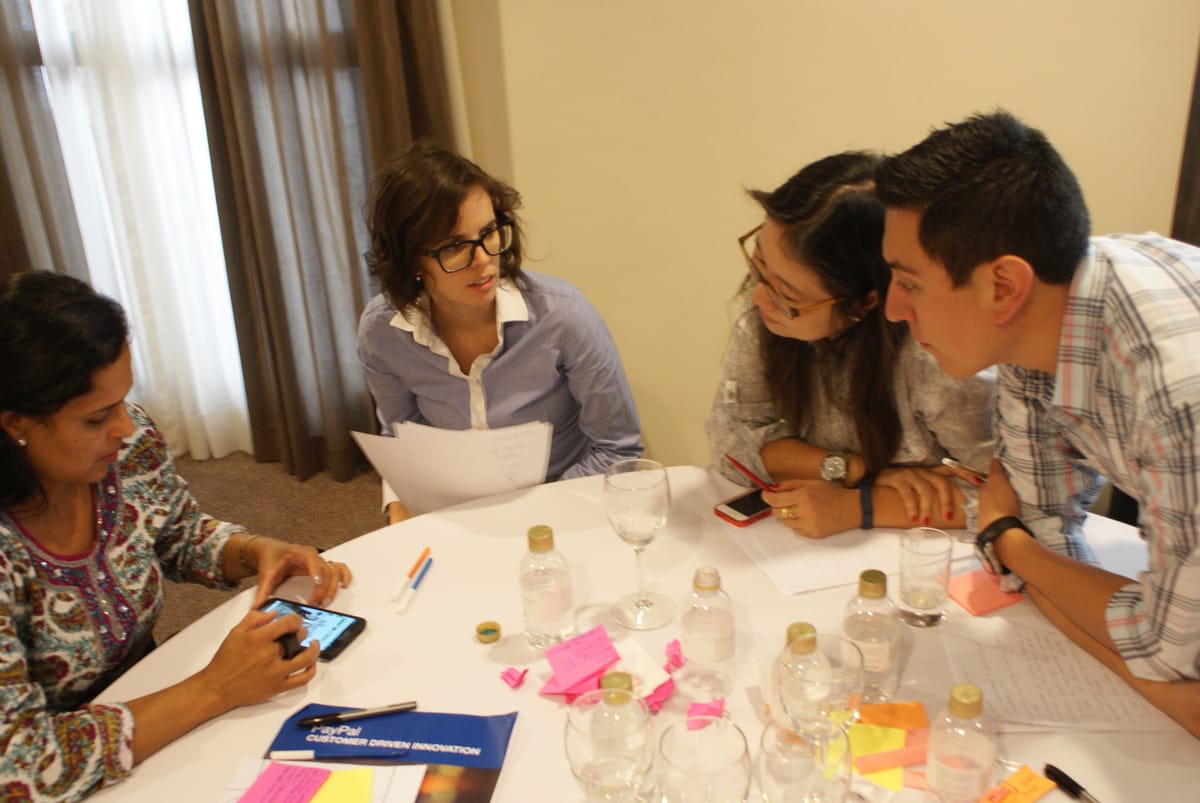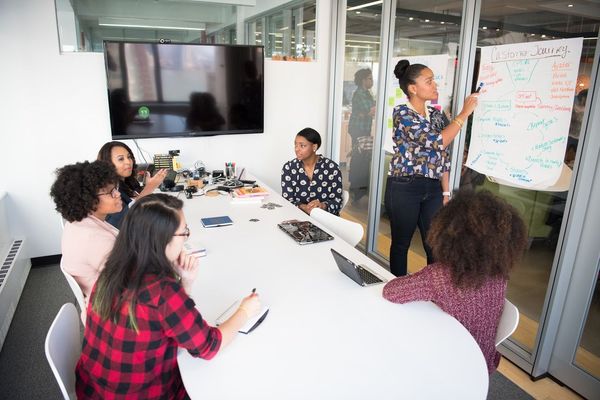Guide your team to better customer interviews

Dear Product Leader,
Talking to users, interviewing customers, meeting prospects, and any variants you want to name are foundational tasks for any Product Manager. Talking to users with a curious, humble, and non-judgemental mind allows us to dig deeper into the customer's pain points, understand their journey, and reflect to identify unmet needs where business value can be maximized.
I want to share some advice about what I have learned about talking to users.
Recruiting your users
The first and most obvious step is to recruit your users. I think Teresa Torres suggests the best approach in her book Continuous Discovery Habits, in which she explains how to set up a recurring pipeline of customers to talk to every week. Assuming most companies are not following this approach (yet), it will be your role to find a way to set it up. I strongly recommend reading the book and finding the best way to make it happen. The easiest way is a link on your website or app to let customers voluntarily sign up and book a slot with your team.
In my experience, less than 30 minutes works best for users; beware that your team might initially feel short conducting such short interviews. To help your team overcome this feeling, you need to have a constant stream of customers, allowing your team to focus on the user and a couple of topics per interview while reviewing the list of open questions they might have.
If you're lucky to work at a company that can hire an agency prospect and recruit users for you (like it was for me when I worked at PayPal), I still recommend implementing Teresa Torres' system and leaving the agency for cases when you have specific target needs or customers who pass certain criteria; for example, once at PayPal, we wanted to interview customers who had received a remittance from a family member in the United States.
Define your goals and questions.
Before talking to users, you need to identify your business goal clearly. I love Melissa Perri's definition of Strategic Intent, outlined in her marvelous book "Escaping the Build Trap":
Although the vision should remain stable over a long period of time, how you intend to reach that vision changes as your company matures and develops. Strategic intents communicate the company's current areas of focus that help realize the vision. Strategic intents usually take a while to reach, on the magnitude of one to several years.
Strategic intents are always aligned to the current state of the business. "What is the most important thing we can do to reach our vision, based on where we are now?" There should not be a laundry list of desires or goals – just a few key things that need to happen to make a big leap forward. Keeping the list of strategic intents small focuses everyone.
Ensure your team keeps the Strategic Intent in mind before defining the questions. From there, your team can translate that goal into research questions to ask customers. If your company is at an early stage, you might explore a theme more in general before coming up with your list of questions.
Tips to define the questions
With a clear goal, you can guide your team in defining questions by considering the following advice. I will use examples of a user interview for a music streaming service to make it more straightforward for you.
Always ask open, non-leading questions.
Binary questions should be banned when talking to users. The best questions let the customer reflect and express their opinion. For example, instead of asking, "Do you like listening to music?" which might constrain the user to a binary answer, you can ask, "In which situations do you enjoy listening to music?". This second version asks about the specific moments when the user might listen to music, but we're adding another dimension: enjoyment. Their answer will provide you and your team with richer insights.
This rule also applies to follow-up questions. Your team must privilege paraphrasing what the user said instead of summarizing and asking for a yes or no confirmation.
Rely on memory rather than opinion.
I have witnessed users who say one thing, but when recalling the last time, they did the opposite. This happened to me at PayPal when interviewing users in Brazil about how they top up their internet mobile credit. Most users would talk about and value convenience when asking how they feel about the top-up experience. However, when asking them to remember the last time they did it, most of them were, in fact, going through the less convenient option, notably because of a force of habit and the relevance of cash in Brazil.
So, what can you and your team do? Phrase your questions and center them around the last time that something happened. For example, "Tell me about the last time you shared a song with someone. Why did you want to share the song, and how did you do it?" This type of question will center the user at a specific moment in their life when the event occurred, and from there, it would be easier for them to recall how they did it accurately. Another advantage is that you and your team might get a more accurate account of the emotions they went through.
Try to situate the user in a context at a specific time and place and guide them to tell you their experience chronologically. You can start by asking them to describe the time and place where they were and how they felt. From there, you can proceed sequentially and pay attention to the change in their emotions.
Conducting user interviews
The moment has arrived, and you and your team will finally meet a user. Assuming that you have prepared everything you need to make the interview happen, ideally face-to-face, but if not possible, with a video conference, remember to make it easy for the volunteer user to join you, connect on time, and be highly respectful of their agreed-upon time.
You need a facilitator and a note-taker.
I strongly recommend having at least two people in the interview; one would be the facilitator, leading and asking all the questions, and the other would take notes. Nowadays, there are multiple Generative AI solutions to record, transcribe, and summarize customer interviews. While they do a lot of heavy lifting, your team will have more significant benefits in the long term if there is a rotation to participate in the user interviews. I also have found it extremely valuable to include Design and Engineering in the rotation.
Start by building rapport and make them feel at ease.
When your team starts the process of continuous customer interviews, it is expected that they will feel some anxiety, notably for the introverts on your team. It helps to have an eager volunteer conduct the first interviews while the others learn from her.
The first couple of minutes of the interview are for building rapport with the user. Even if they are compensated for their time, try to keep it separate or address it only at the end.
Treat the user as an individual and ask questions about family, occupation, or recreation (hobbies). Essentially, it is small talk to connect with the interviewee quickly.
Ask your team to remind users that there are no right or wrong answers and that they will not judge them in any way.
Don't talk about your product.
If you're an early-stage company, this is not the moment to pitch your product. You're there to learn from them, not to convince them to buy from you. You can discuss your high-level mission and clarify that you want to understand users and that their honest input will be highly appreciated and used in developing the product.
Ask permission to record the interview and take a profile picture.
The more interviews you and your team start to have, the more likely they are to start mixing customers and their problems, so recording the interviews for future reference is a good practice. Of course, you have to ask for explicit consent from the user, and some companies even require signing a form beforehand.
A picture is worth a thousand words, and when you and your team are writing and reviewing the interview brief, looking at the user's picture will help them remember more insights. When I took MIT's "Mastering Design Thinking" course, my team project was about food preferences and allergies. We interviewed users in restaurants and took their pictures there, which allowed us to remember their experience better when choosing their food.
Don't ask what they want.
Remember that you are exploring a problem and understanding your users and their habits, needs, desires, and pain points. So, avoid asking the straight question, "What would you do if you had a magic wand?" Even if it sounds tempting, it has a high risk of becoming a bias for your team in the long term.
Even if you don't ask, customers will likely try to give you a straight solution; most of the time, it will be a button that performs a particular action. I advise asking them why they need that specific feature, digging deeper into understanding their pain point, and paying attention to any shortcuts or workarounds they might be implying.
Refrain from offering a solution or workaround.
You and your team might encounter multiple situations where the user is facing a problem when using your product, and as hard as it might be, I suggest avoiding instructing them on how to do it. Take a note of it for your Design partner and discuss it as part of the insights. If you feel it is really causing pain and there is a way to explain it, make a note and address it at the end of the interview.
Find out if and how you can help the users with an issue they are experiencing.
I've also experienced cases at ManoMano when a user would tell me about an issue they have faced and ask me for support to connect or escalate the situation. I advise you to partner with your Customer Service Team before you start the interviews and discuss the best way to address those situations. Maybe your company has an internal escalation process, or maybe it is OK for you to contact a Customer Service Supervisor (or an Account Manager for B2B). And be clear with the user about what you can do to help and follow up.
Gathering insights and synthesizing them to make them actionable.
During the interview, someone will take notes while the facilitator asks the questions. I advise booking time right after the interview so that you and your team can discuss and gather insights from that user. If you don't do it immediately after, you risk forgetting some valuable information.
There are different templates out there that you can use. I use Teresa Torre's as a starting point and complement as required by the strategic intent we're pursuing. Essentially, your team should collect the following data into the summary interview and ideally keep it as a one-pager:
- Customer info: First name, last name initial, age, occupation, and location.
- Picture
- The most relevant quote you've captured.
- Quick facts: A collection of data points related to what you have discovered about how the user thinks and acts. These should come directly from the interview without assumptions or interpretations.
- Insights: Ideally, your team identifies this group of ideas during the debrief. The insights will be the foundation for helping you identify patterns in user behavior.
- Opportunities: After finding and analyzing the insights, your team can identify the opportunities that align with your strategic intent and are worth exploring deeper.
Your team should use this collection of summaries to develop opportunities and solutions collectively with Engineering and Design, which I will explore in future articles.
Summary
We've just explored why talking to users is crucial for anyone in product management. I've shared some of the best ways to get users lined up for interviews, just like Teresa Torres recommends in her book Continuous Discovery Habits. It's all about ensuring you have a steady flow of honest conversations with customers, and I offered some practical tips on making these chats as effective as possible.
I also discussed the need to clearly define what we want to achieve before we start chatting with users, taking a leaf out of Melissa Perri's book Escaping the Build Trap, where she discusses "Strategic Intent." It’s all about keeping your company’s current focus in mind to ensure the conversation stays relevant.
When it comes to conducting the interviews, I emphasized the importance of asking questions that open up the conversation rather than closing it down. We must dig deep into users' real-life experiences without leading them to specific answers. And it's not just about what they say but how they say it—paying attention to this can reveal much more than their words alone.
I shared some of my personal experiences in handling user interviews, including who should be in the room and how to make everyone, including the user, feel comfortable. Building a quick connection and a comfortable atmosphere are vital to getting honest insights.
Finally, I stressed the importance of wrapping up these interviews with a good debrief. Gathering all the insights right away while they're fresh is crucial. We use these insights to spot patterns and opportunities that align with our strategic goals, helping us make better decisions for our product and ultimately driving more value for our business.
So that’s all, folks —talking to users isn't just a task on the checklist; it's a core part of developing products that meet people's needs. Your role as Product Leader is to lead by example, empower, and facilitate customer access for your team.
Until next time, may the Force be with you.




